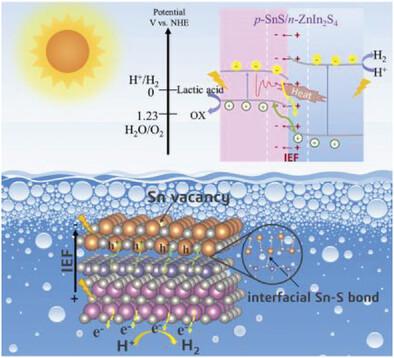当前位置:
X-MOL 学术
›
Adv. Funct. Mater.
›
论文详情
Our official English website, www.x-mol.net, welcomes your
feedback! (Note: you will need to create a separate account there.)
Interfacial Mediation by Sn And S Vacancies of p-SnS/n-ZnIn2S4 for Enhancing Photocatalytic Hydrogen Evolution with New Scheme of Type-I Heterojunction
Advanced Functional Materials ( IF 18.5 ) Pub Date : 2023-08-27 , DOI: 10.1002/adfm.202304072
Xiaofang Jia 1 , Yue Lu 1 , Kunrong Du 1 , Huibin Zheng 2 , Liang Mao 3 , Hao Li 4 , Zhaoyu Ma 1 , Rongming Wang 4 , Junying Zhang 1
Advanced Functional Materials ( IF 18.5 ) Pub Date : 2023-08-27 , DOI: 10.1002/adfm.202304072
Xiaofang Jia 1 , Yue Lu 1 , Kunrong Du 1 , Huibin Zheng 2 , Liang Mao 3 , Hao Li 4 , Zhaoyu Ma 1 , Rongming Wang 4 , Junying Zhang 1
Affiliation

|
The construction of interfacial electric field (IEF) in semiconductor heterojunction is of great significance in boosting photocatalytic hydrogen evolution through efficient separation of photogenerated charge-carriers. However, the exploitation of IEF in type-I heterojunction has not been proposed for designing photocatalysts. Herein, based on the density functional theory prediction, p-SnS with different work functions modulated by Sn-vacancy are compounded with n-ZnIn2S4 containing S-vacancy to form type-I heterojunction. The optimized SnS/ZnIn2S4 photocatalyst without co-catalysts exhibits an impressive hydrogen evolution rate of 22.75 mmol g−1 h−1, 6.23 times of ZnIn2S4. Systematic investigations reveal that the interfacial Sn-S bond acts as a transport channel that accelerates the interface charge-carriers transfer under the promotion of IEF originating from the significant Fermi level difference. A large difference in the surface photovoltage signal of SnS/ZnIn2S4 and ZnIn2S4 is achieved from effective photogenerated charge-carriers separation by IEF. The new p-n type-I scheme of SnS/ZnIn2S4 induced by the interfacial mediation can separate the photogenerated charge-carriers, and retain the highly reductive electrons of ZnIn2S4 for hydrogen evolution, overcoming the disadvantage of reduction potential decline in the typical type-I scheme. This study will afford a new theoretical basis for the achievement of high-efficiency photocatalytic hydrogen evolution through interface modulation.
中文翻译:

p-SnS/n-ZnIn2S4 的 Sn 和 S 空位的界面介导通过 I 型异质结的新方案增强光催化析氢
半导体异质结中界面电场(IEF)的构建对于通过光生载流子的有效分离促进光催化析氢具有重要意义。然而,尚未提出在 I 型异质结中利用 IEF 来设计光催化剂。在此,基于密度泛函理论预测,受Sn空位调制的不同功函数的p -SnS与含有S空位的n - ZnIn 2 S 4复合形成I型异质结。没有助催化剂的优化SnS/ZnIn 2 S 4光催化剂表现出令人印象深刻的22.75 mmol g -1 h -1的析氢速率,是ZnIn 2 S 4的6.23倍。系统研究表明,界面 Sn-S 键作为传输通道,在显着费米能级差异的 IEF 促进下加速界面载流子传输。SnS/ZnIn 2 S 4和ZnIn 2 S 4表面光电压信号的巨大差异是通过IEF有效的光生载流子分离实现的。界面介导诱导的SnS/ZnIn 2 S 4新型pn I型方案可以分离光生载流子,并保留ZnIn 2 S 4的高还原性电子用于析氢,克服了还原电位下降的缺点。典型的I型方案。该研究将为通过界面调制实现高效光催化析氢提供新的理论基础。
更新日期:2023-08-27
中文翻译:

p-SnS/n-ZnIn2S4 的 Sn 和 S 空位的界面介导通过 I 型异质结的新方案增强光催化析氢
半导体异质结中界面电场(IEF)的构建对于通过光生载流子的有效分离促进光催化析氢具有重要意义。然而,尚未提出在 I 型异质结中利用 IEF 来设计光催化剂。在此,基于密度泛函理论预测,受Sn空位调制的不同功函数的p -SnS与含有S空位的n - ZnIn 2 S 4复合形成I型异质结。没有助催化剂的优化SnS/ZnIn 2 S 4光催化剂表现出令人印象深刻的22.75 mmol g -1 h -1的析氢速率,是ZnIn 2 S 4的6.23倍。系统研究表明,界面 Sn-S 键作为传输通道,在显着费米能级差异的 IEF 促进下加速界面载流子传输。SnS/ZnIn 2 S 4和ZnIn 2 S 4表面光电压信号的巨大差异是通过IEF有效的光生载流子分离实现的。界面介导诱导的SnS/ZnIn 2 S 4新型pn I型方案可以分离光生载流子,并保留ZnIn 2 S 4的高还原性电子用于析氢,克服了还原电位下降的缺点。典型的I型方案。该研究将为通过界面调制实现高效光催化析氢提供新的理论基础。

































 京公网安备 11010802027423号
京公网安备 11010802027423号